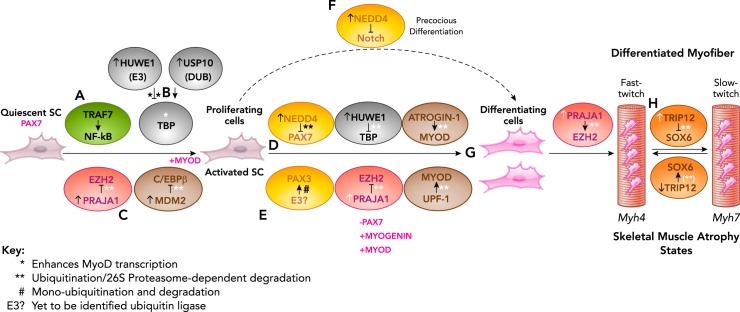FIGURE 8.
Summary of the role of ubiquitin ligase regulation of transcription factors during myocyte differentiation (myogenesis)
A: TRAF7’s ubiquitin ligase activity activates NF-κB signaling via NEMO ubiquitination to support the SC proliferation. B: the TBP transcription factor is regulated by the HUWE1 ubiquitination ligase and the USP1 deubiquitinase to maintain stable levels of TBP during proliferation stage. However, in the later stages, there is an increase in Huwe1 and a decrease in USP1 levels, thereby leading to reduced TBP levels, which is essential for differentiation. C: the PRAJA1 and MDM2 ubiquitin ligases are increased during proliferation, and poly-ubiquitinate and degrade the EZH2 and C/EBPβ, respectively, effectively releasing the inhibition on proliferation. PRAJA1 levels are tightly regulated throughout the myogenic lineage, which in a positive feedback loop mechanism degrades phosphorylated EZH2, a vital gene regulator in myogenesis. D: the NEDD4 ubiquitin ligase inhibits PAX7 protein levels during myogenesis while a yet to be identified ubiquitin ligase (E3?) inhibits the PAX3 transcription factor (E). NEDD4 leads to PAX7 depletion by ubiquitination and 26S proteasome degradation. F: NEDD4 also inhibits Notch signaling to accelerate differentiation in an unrelated mechanism. G: the ubiquitin ligases atrogin-1 and UPF-1 independently degrade MYOD, thereby modulating MYOD levels essential for differentiation. H: the TRIP12 ubiquitin ligase regulates SOX6 protein levels to control the transition of fast-twitch fibers to slow-twitch fibers. *Enhances MyoD transcription. **Ubiquitination/26S proteasome-dependent degradation. #Mono-ubiquitination and degradation. E3? , yet to be identified ubiquitin ligase.

